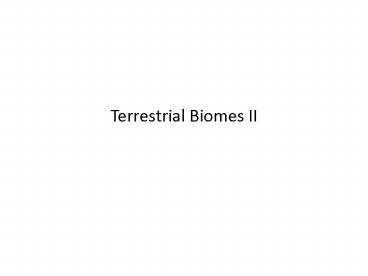Terrestrial Biomes II - PowerPoint PPT Presentation
1 / 34
Title:
Terrestrial Biomes II
Description:
Devoid of trees except along water courses (riparian vegetation) and near ... Historic habitat of bison and pronghorn. Best left as grazing land. Plains ... – PowerPoint PPT presentation
Number of Views:22
Avg rating:3.0/5.0
Title: Terrestrial Biomes II
1
Terrestrial Biomes II
2
Figure 3.D Temperate Grasslands
3
Temperate Grassland
- Devoid of trees except along water courses
(riparian vegetation) and near springs and seeps - Maintenance historically based on fires and
grazing by large herbivores. - Annual rainfall 300-1,000 mm coincides with
growing season. - Soils typically nutrient rich and deep.
- Formerly gt 1 million mi.2 of grassland in
mid-North America.
4
- Grassland classification in U.S.
- 1. Plains short grasses
- 2. Mixed prairie mixture of short and tall
grass species - 3. Tall grass prairie tall grass species
- East-west precipitation gradients.
- Exploitation overgrazing and mismanaged as farm
land (topsoil loss from erosion). - Most of the biomass is in the roots.
5
In N.A., W of 100th meridian Farming plains
requires irrigation Historic habitat of bison and
pronghorn Best left as grazing land
Plains
6
Former location is where wheat-farming is
presently concentrated Rich soil - high humus
Mixed prairie
7
Former location was where non-irrigated corn and
soybean agriculture is presently
concentrated Rich soil - high humus
Tall grass prairie
8
Grassland climates
9
Back in the good old days.
Ninth Street, Boulder, Colorado 1886
10
(No Transcript)
11
Mediterranean Woodland and Shrubland
- Chapparal (evergreen shrubs) occurs on west
coasts of continents with Mediterranean climates. - Winter rain, mild winter temps, summer drought.
- Maintained by periodic fires.
- Fragile soils with moderate fertility.
- Great housing developments in southern
California. - Continental woodlands trees typically evergreen.
12
Representative Mediterranean Woodland and
Shrubland Climates
13
(No Transcript)
14
Representative Temperate Deciduous Forest Climates
15
Temperate Forest (Old Growth)
- Majority lie between 40o and 50o latitude.
- Warm summers, cold winters (below freezing).
- Fertile soils
- Regions with long growing seasons dominated by
deciduous trees. - Regions with short growing seasons dominated by
conifers. - Biomass production can be very high (3-4 metric
tons of leaves/hectare/year). - Many major human population centers.
16
Vertical stratification
17
(No Transcript)
18
(No Transcript)
19
Representative Boreal Forest (Taiga) climates
20
Figure 3.I Tundra
21
Tundra climates
22
VeFigure 3.11 Mountain Biological Zones
Vegetative zonation in mountains 2,200 m gain in
elevation approx. equivalent to shift northward
27o latitude.
23
Figure 3.12 Tropical Alpine Plants
Tropical Alpine Dominants
24
Figure 3.13 Stream Orders
Lotic ecosystems
25
Figure 3.14 Spatial Zonation of a Stream
26
Coastal ecosystems Salt marshes
27
Coastal ecosystems Mangrove swamps
28
Intertidal zone
29
Figure 3.15 Examples of Lake Plankton
In all aquatic ecosystems
30
Figure 3.16 Marine Biological Zones
Oceanic zonation
31
Estuaries where rivers meet oceans Productivity
high
32
Satellite photo of a coral reef
33
Figure 3.22 A Coral Reef
34
Figure 3.24 A Kelp Bed
Kelp forest































